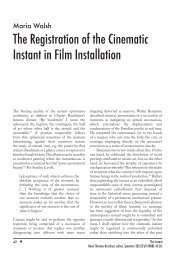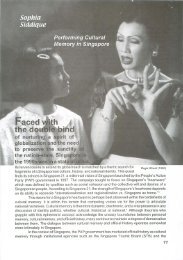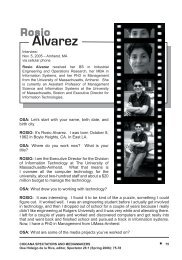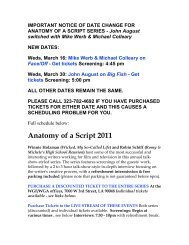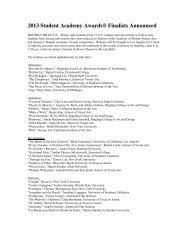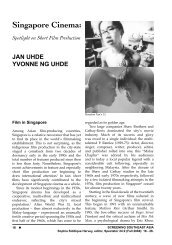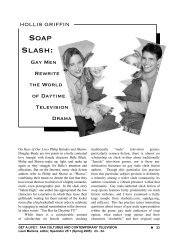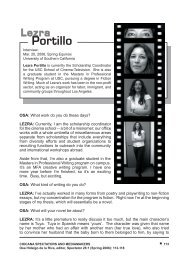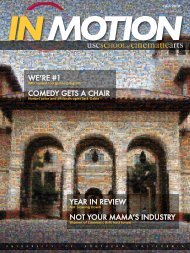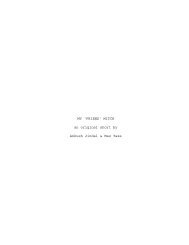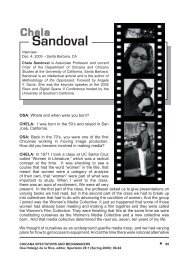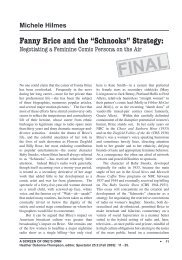The Instant Replay - USC School of Cinematic Arts - University of ...
The Instant Replay - USC School of Cinematic Arts - University of ...
The Instant Replay - USC School of Cinematic Arts - University of ...
Create successful ePaper yourself
Turn your PDF publications into a flip-book with our unique Google optimized e-Paper software.
product within the gendered household.” 22 <strong>The</strong>se<br />
devices actively and digitally record “live” television,<br />
allowing the user to instantly and precisely “pause”<br />
and “rewind” what she watches—much like a VCR,<br />
but without cumbersome electromagnetic cassette<br />
system used in the VCR. 23 <strong>The</strong> remote control<br />
for the TiVo includes an instant replay button,<br />
which will automatically “jump” the user back<br />
three seconds in her program; an advertisement<br />
for TiVo proclaims, “<strong>Instant</strong> replay in the palm <strong>of</strong><br />
your hand!” Similarly, digital cable services such<br />
as OnDemand allow users to stream or download<br />
programs from a central video computer server to<br />
their television and typically feature pause, rewind<br />
and fast-forward capability. All <strong>of</strong> these devices<br />
indicate a fundamental shift in both televisual and<br />
cinematic viewing practices, with replay as a central<br />
unifying and structuring logic. <strong>The</strong> instant replay<br />
has thus become a pivotal and implied component<br />
<strong>of</strong> our televisual experience; the capacity to<br />
actively and instantly rewind and replay portions<br />
<strong>of</strong> programming—even that which is “live”—is<br />
becoming both a familiar feature <strong>of</strong> the remote<br />
control and a requisite attribute <strong>of</strong> the server-based<br />
distribution <strong>of</strong> programming. This user-controlled<br />
deployment <strong>of</strong> programming has already begun to<br />
affect conventional broadcast strategies (such as<br />
HBO’s <strong>of</strong>fering <strong>of</strong> new episodes <strong>of</strong> shows a week<br />
before their broadcast) and may soon replace them<br />
altogether.<br />
<strong>The</strong>se recent digital technologies can be<br />
seen as direct challenges to Raymond Williams’s<br />
notion <strong>of</strong> “flow,” and their basis in early magnetic<br />
recording equipment indicates that a discussion <strong>of</strong><br />
the instant replay necessitates a re-consideration<br />
<strong>of</strong> Williams. In his seminal book Television:<br />
Technology and Cultural Form, Williams argues that<br />
the experience <strong>of</strong> television is characterized by the<br />
concept <strong>of</strong> flow. He suggests that early television<br />
broadcasts were marked by their intervallic<br />
nature—programming was broken up into discrete<br />
units that were <strong>of</strong>ten separated by pauses, during<br />
which time the station might broadcast a sound<br />
or image (such as the BBC’s spinning globe) to<br />
indicate that the broadcasting service remained<br />
active. 24 However, as a result <strong>of</strong> the commercial<br />
nature <strong>of</strong> much <strong>of</strong> more recent television<br />
broadcasting, television is marked by a continuous<br />
flow <strong>of</strong> images and sounds, as programming and<br />
THE insTanT<br />
hAnSon<br />
commercials stream in an uninterrupted fashion:<br />
“<strong>The</strong>re has been a significant shift from the concept<br />
<strong>of</strong> a sequence as programming to the concept <strong>of</strong><br />
sequence as flow.” 25 Thus what was once marked by<br />
distinct programming units with intervals is now<br />
an incessant stream. For Williams, “flow” names<br />
television’s sense <strong>of</strong> the perpetual now—its means<br />
<strong>of</strong> keeping the viewer’s attention from moment to<br />
moment and from program to program. Indeed,<br />
it might be considered the stream <strong>of</strong> television’s<br />
consciousness.<br />
Duration, Memory, and the <strong>Replay</strong><br />
Williams’s concept immediately recalls Henri<br />
Bergson’s notion <strong>of</strong> “duration” as our perceptual<br />
and intuitive experience <strong>of</strong> the continuous flow<br />
<strong>of</strong> time. While science and culture insist upon<br />
structuring and organizing time into discrete units<br />
such as seconds and years, Bergson instead asserts<br />
that our temporality is marked by its constancy and<br />
continuity: durée. Bergson’s theoretical approach<br />
is particularly constructive in an analysis <strong>of</strong> the<br />
replay as his examination <strong>of</strong> perceptual experience<br />
is uniquely analogous to several key considerations<br />
<strong>of</strong> television’s ontology. For instance, Herbert<br />
Zettl argues that the very essence <strong>of</strong> the physical<br />
apparatus <strong>of</strong> television is one <strong>of</strong> motion and a state<br />
<strong>of</strong> becoming; unlike film, television constantly<br />
rescans its image into the camera and redraws this<br />
image onto the screen:<br />
While in film each frame is actually a static<br />
image, the television image is continually<br />
moving, very much in the manner <strong>of</strong> the<br />
Bergsonian durée. <strong>The</strong> scanning beam is<br />
constantly trying to complete an always<br />
incomplete image. Even if the image on<br />
the screen seems at rest, it is structurally<br />
in motion. Each television frame is always<br />
in a state <strong>of</strong> becoming. While the film<br />
frame is a concrete record <strong>of</strong> the past, the<br />
television frame (when live) is a reflection<br />
<strong>of</strong> the living, constantly changing present.<br />
<strong>The</strong> live televised event and the event<br />
itself exist in the same present. This is<br />
impossible with film. 26<br />
Thus while the cinematic apparatus is characterized<br />
55




